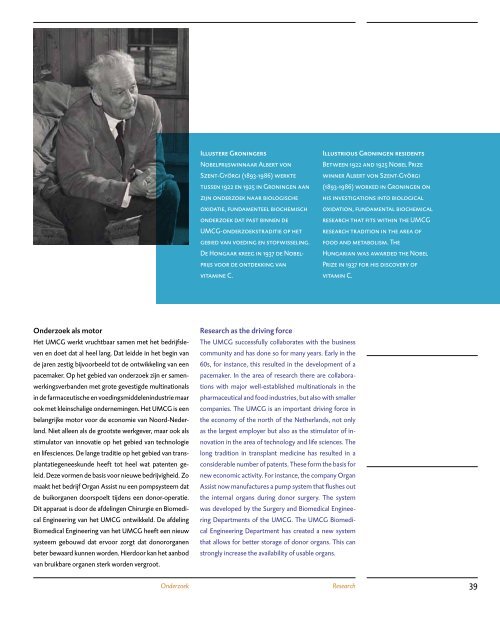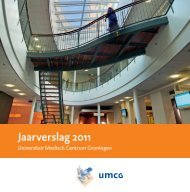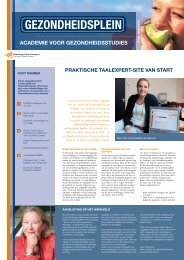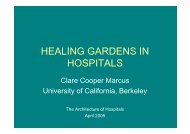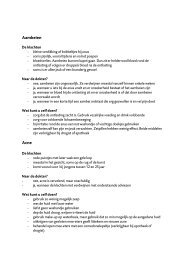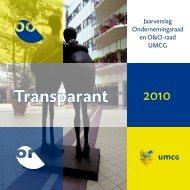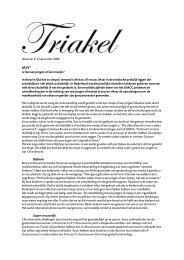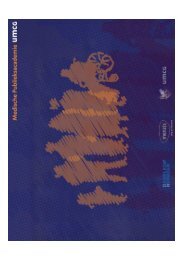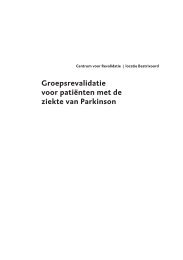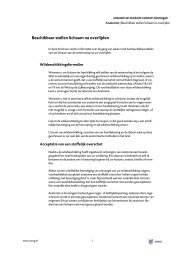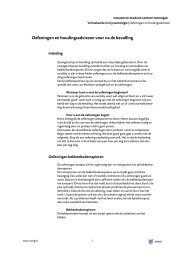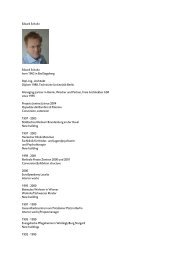Universitair Medisch Centrum Groningen University Medical ... - Umcg
Universitair Medisch Centrum Groningen University Medical ... - Umcg
Universitair Medisch Centrum Groningen University Medical ... - Umcg
Create successful ePaper yourself
Turn your PDF publications into a flip-book with our unique Google optimized e-Paper software.
Illustere Groningers<br />
Nobelprijswinnaar Albert von<br />
Szent-Györgi (1893-1986) werkte<br />
tussen 1922 en 1925 in <strong>Groningen</strong> aan<br />
zijn onderzoek naar biologische<br />
oxidatie, fundamenteel biochemisch<br />
onderzoek dat past binnen de<br />
UMCG-onderzoekstraditie op het<br />
gebied van voeding en stofwisseling.<br />
De Hongaar kreeg in 1937 de Nobelprijs<br />
voor de ontdekking van<br />
vitamine C.<br />
Illustrious <strong>Groningen</strong> residents<br />
Between 1922 and 1925 Nobel Prize<br />
winner Albert von Szent-Györgi<br />
(1893-1986) worked in <strong>Groningen</strong> on<br />
his investigations into biological<br />
oxidation, fundamental biochemical<br />
research that fits within the UMCG<br />
research tradition in the area of<br />
food and metabolism. The<br />
Hungarian was awarded the Nobel<br />
Prize in 1937 for his discovery of<br />
vitamin C.<br />
Onderzoek als motor<br />
Het UMCG werkt vruchtbaar samen met het bedrijfsleven<br />
en doet dat al heel lang. Dat leidde in het begin van<br />
de jaren zestig bijvoorbeeld tot de ontwikkeling van een<br />
pacemaker. Op het gebied van onderzoek zijn er samenwerkingsverbanden<br />
met grote gevestigde multinationals<br />
in de farmaceutische en voedingsmiddelenindustrie maar<br />
ook met kleinschalige ondernemingen. Het UMCG is een<br />
belangrijke motor voor de economie van Noord-Nederland.<br />
Niet alleen als de grootste werkgever, maar ook als<br />
stimulator van innovatie op het gebied van technologie<br />
en lifesciences. De lange traditie op het gebied van transplantatiegeneeskunde<br />
heeft tot heel wat patenten geleid.<br />
Deze vormen de basis voor nieuwe bedrijvigheid. Zo<br />
maakt het bedrijf Organ Assist nu een pompsysteem dat<br />
de buikorganen doorspoelt tijdens een donor-operatie.<br />
Dit apparaat is door de afdelingen Chirurgie en Biomedical<br />
Engineering van het UMCG ontwikkeld. De afdeling<br />
Biomedical Engineering van het UMCG heeft een nieuw<br />
systeem gebouwd dat ervoor zorgt dat donororganen<br />
beter bewaard kunnen worden. Hierdoor kan het aanbod<br />
van bruikbare organen sterk worden vergroot.<br />
Onderzoek<br />
Research as the driving force<br />
The UMCG successfully collaborates with the business<br />
community and has done so for many years. Early in the<br />
60s, for instance, this resulted in the development of a<br />
pacemaker. In the area of research there are collaborations<br />
with major well-established multinationals in the<br />
pharmaceutical and food industries, but also with smaller<br />
companies. The UMCG is an important driving force in<br />
the economy of the north of the Netherlands, not only<br />
as the largest employer but also as the stimulator of innovation<br />
in the area of technology and life sciences. The<br />
long tradition in transplant medicine has resulted in a<br />
considerable number of patents. These form the basis for<br />
new economic activity. For instance, the company Organ<br />
Assist now manufactures a pump system that flushes out<br />
the internal organs during donor surgery. The system<br />
was developed by the Surgery and Biomedical Engineering<br />
Departments of the UMCG. The UMCG Biomedical<br />
Engineering Department has created a new system<br />
that allows for better storage of donor organs. This can<br />
strongly increase the availability of usable organs.<br />
Research<br />
39


